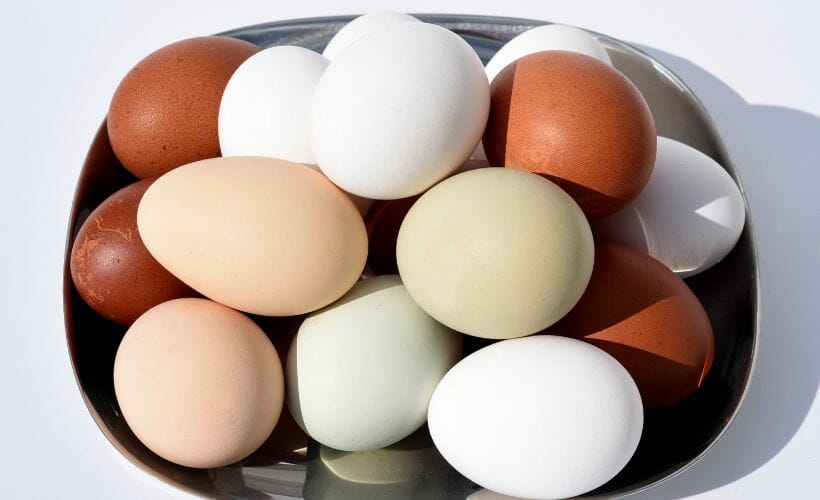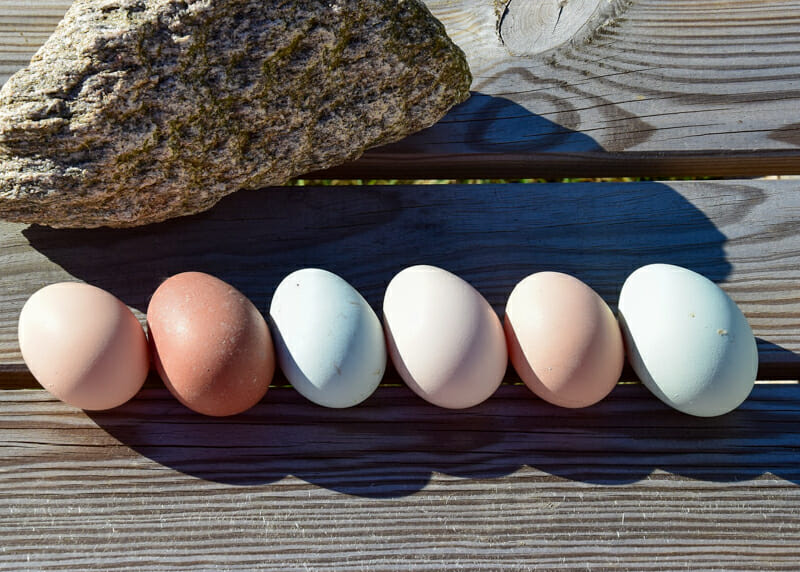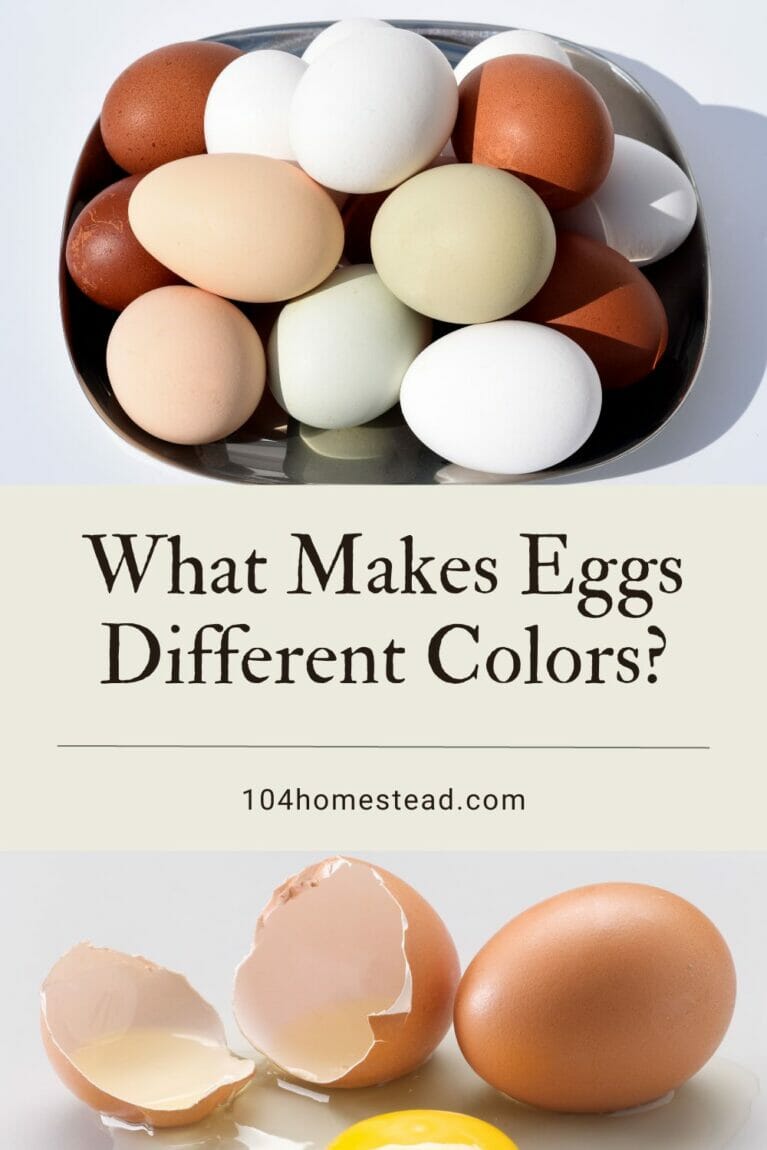Egg Anatomy: What Makes the Eggshells Different Colors
Eggs are one of the most versatile foods, but have you ever wondered about what part of the egg anatomy makes eggshells different colors?

In this photo below (I know, terrible quality — my apologies) as well as the photo above, there are only two colors of eggs.

Okay, so right now you are probably either trying to figure out the punchline or you’re cleaning your glasses. I kid you not. The eggs in the picture above are only two colors. White and blue. In fact, at their core, all chicken eggs are white or blue. But what about the brown and green ones? What about purple and pink? Before we get into how all the color shades are made, first we have to delve into a bit of chicken anatomy.
Chicken Anatomy
Each egg takes a twenty-six-hour trip down the hen’s oviduct. Twenty of those hours are devoted to shell formation. Two hours is travel. The eggshell is colored in the final two hours before being laid.
In some chicken breeds, a pigment called protoporphyrin is slowly added to the shell as it travels down the oviduct. Protoporphyrin is brown-colored. Depending on the breed of the hen, the coating will be light, dark, or somewhere in between.
Protoporphyrin does not penetrate the shell. It only tints the surface. It can be washed off, leaving only a bit of staining with really dark eggs, or it can be sanded off with fine sandpaper. If your eggs have a mottled appearance, there was the addition of porphyrins as well when the egg was making its travels.

Don’t be grossed out, but porphyrins are actually produced by the breakdown of red blood cells.
Fun Facts
The blue egg shells come from a pigment called oocyanin, which is a byproduct of bile. Some researchers believe that this byproduct was triggered by an infection long ago.
A material referred to as bloom coats the egg as it leaves the hen and this miracle material protects the egg from any bacteria getting inside by sealing the 6,000-8,000 shell pores. That’s why in most countries they are sold unwashed and at room temperature. You can learn why the US does things differently here.
My Flock’s Eggs
Okay, so now that we know the science behind egg color, let’s take another look at my eggs. We’ll start with the easy ones. The ones that appear blue and green. The blue egg comes from an Ameraucana. The green egg comes from a Silkie [brown egg layer]/Ameraucana. The Silkie mix would be deemed an Easter Egger.

Now, this is where it gets exciting. This next photo shows a white egg from my Brown Leghorn. The photo next to it is from my Marans [chocolate-brown egg layer]. Even with that rich, dark brown coloring, the interior is white.

Check the Egg Anatomy Out Yourself
Want to test this theory out on your own eggs? It’s a fun experiment on egg anatomy for kids and grownups. After cracking your egg, slowly peel away the shell membrane inside. Rinse the egg interior thoroughly with warm water and allow it to dry.
For even more fun, try rubbing away the pigment on the outside of the egg with your finger, a wet cloth, an eraser, or some fine-grit sandpaper. See if you can get the eggshell back to its base color.
How All Eggs Are the Same?
Once you get past the shell color, every chicken’s egg anatomy is the same. An egg has eight different parts: the shell (which we have discussed), as well as a yolk, the vitelline membrane, an air cell, the chalazae, the albumen, an inner membrane, and an outer membrane. Each part of the egg serves a different purpose.
The Shell
Regardless of what color it is, this is the outer layer of the egg which is made up of calcium carbonate. The shell contains between 6,000 to 8,000 tiny pores which allow moisture to pass through.
The Yolk
The yolk contains the most minerals and vitamins in the egg. It contains calcium, iron, phosphorus, thiamine, riboflavin, Vitamin A, and Vitamin D. The yolk is made up of more protein than egg white and also contains less water. Depending on what you feed your hen, the yolk color ranges from slightly yellow to deep orange.
The Vitelline Membrane
Also called the yoke sac, this is the clear casing that encloses the surface of the yolk.

The Air Cell
The air cell can be found between the inner and outer membranes of the egg’s largest end. After an egg is laid this air space forms while the egg is cooling and contracting. The air cell expands as the egg ages.
The Chalazae
This looks like a little white rope and serves as the yolk’s anchor making sure the yolk stays in the center of the egg. When the chalazae are very prominent, your eggs are fresher.
The Albumen
This is also known as egg white. The albumen consists of four different layers that alternate between thick and thin, consisting of forty different proteins. The egg white is the main component of the egg in addition to water.
The Inner Shell Membrane and Outer Shell Membrane
These strong membranes are made partly of keratin and are found lying between the eggshell and egg white. They fight off any bacterial invasion.
Next Week…
If you have wanted a particular hue in your egg basket, I’m going to let you in on the secrets of making it happen. Next week we’ve got: The Science of Creating Egg Color.
What’s your favorite colored egg? Comment below!


My daughter would absolutely love mauve eggs! Can you offer any advice on which colors/breeds to mix, I’m guessing a maran to an ameraucana? ?
I LOVE the blues and greens!! I am dying to have a few chickens. I’m either going to get my little farm one day or become an outlaw chicken keeper since my HOA says no. 🙂
Not that I can condone illegal activities, BUT getting chickens was the best homesteading-related decision I have made.
🙂 I am normally a by-the-book, strict rule follower, but when my neighbor can have two yapper dogs (I have a dog, so I’m not anti-dog) that bark outside all day long, but I can’t have 3 hens to provide compost for my garden and food for my family, it awakens my rebellious side. 😀
I think it’s amusing how THOSE are the people who complain. The only noise complaint we’ve ever received was from a neighbor with four chained up dogs in his yard. Every car, bicyclist and walker set those dogs off. I had a hen with hormonal issues who would abandon her nest and run around frantically squawking and he complained. It hardly compares (PS: We decided she shouldn’t brood anymore. She isn’t mentally stable LOL).
Our chickens have laid their first eggs. I have received 9 eggs in 10 days from 6 hens … not too bad, given this is my first go at raising chickens.
I hope it never gets mundane for you. I still feel like it’s Christmas morning when I got to collect eggs despite how long we’ve had chickens. Each one is cherished.